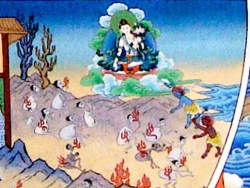The Sarvastivadin Abhidharma
Sarvastivadin Abhidharma' Although the Sarvastivadin version of the Abhidharma-pitaka also has seven texts, these do not generally coincide with those of the Pali Abhidhamma.
And they are not generally taken as a "fixed" canon of seven texts.
Instead there was an Abhidharma tradition of six smaller texts or "legs" that culminated in the development of a seventh, the massive Jnanaprasthana, which in turn led to the writing of the Mahavibhasa, another, later compilation of Sarvastivadin thought.
The first seven texts of the Sarvastivadin Abhidharma are as follows:
1. Sangitiparyay ("section for recitation"): This work lists doctrinal concepts.
2. Dharmaskandha ("aggregate of Dharmas"): This work focuses on Sarvastivadin doctrines, especially concerning the stages of the arhat’s progress.
3. Prajnapti ("book of manifestation"): This work explains cosmology and psychology.
4. Vinanakaya: This work discusses the non-existence of the self.
5. Dhatukaya: This work is another psychological discussion.
6. Prakaranapada ("treatise"): This work discusses all the elements of reality.
7. Jnanaprasthana ("course of knowledge"): This work defines psychological terms.
The Sarvastivada Abhidharma has not survived in its Sanskrit original version—in other words, it does not exist today in Sanskrit. However, it had long before been translated into Chinese, and that version exists.
While one part of the Sarvastivada Abhidharma, the Prajnapti, is not complete in Chinese, it is found in a Tibetan version. So today we are able to say we have complete access to the Sarvastivadin Abhidharma literature.
Chinese travelers collected works from many of the early Indian schools, such as Sthaviravada, Mahasanghika, Sammatiya, Dharma-guptaka, and Sarvastivadin, but only those from the Sarvastivadin Abhidharma were translated into Chinese. Thus the Abhidharma in the Chinese Tripitaka is, strictly speaking, that of the Sarvastivadins.
Source
http://what-when-how.com/buddhism/abhidharmaabhidhamma-to-aitken-robert-baker-buddhism/

